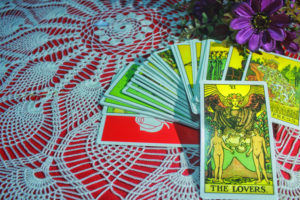
In our contemporary world, tarot cards are frequently regarded with either curiosity or disdain. From religiously fueled fears to superstitions depicted in popular culture, they’re widely misunderstood and are often thought of as nefarious or ill-intentioned. However, a basic understanding of tarot’s origins and uses may unlock a better understanding of this divination method.
From Fun and Games to Divination
Modern tarot decks have their origins in Renaissance-era playing cards, first brought to Europe from the Middle East during the late 14th century. The earliest decks were elaborately illustrated and featured four suits of face and numbered cards, along with several trump cards. Those used for gaming eventually evolved into today’s versions with clubs, diamonds, spades, and hearts suits. The earliest known evidence for playing cards being used in divination and fortune-telling dates to the mid-1700s, making it one of the first forms of cartomancy.
French occultist Jean-Baptiste Alliette is credited with crafting the first professional tarot deck for divination in 1791. His version featured 78 cards, with numbered and royal court cards along with several trumps. It’s from this early deck that later versions arose, including the Rider-Waite-Smith deck, Art Rosengarten’s Tarot of Nine Paths, and the Thoth deck developed by English occultist Aleister Crowley and Lady Frieda Harris.
An Introduction to the Major and Minor Arcana
Most contemporary tarot decks are modeled after Alliette’s original edition, containing 78 cards split into the Major Arcana and the Minor Arcana. The former is made up of 22 trump cards that aren’t assigned to any suits. Numbered 0 through 21 or from 1 to 22, each one is illustrated with symbolic scenery and elements:
- The Fool
- The Magician
- The Empress
- The Emperor
- The Hierophant
- The Lovers
- The Chariot
- Strength
- The Hermit
- Wheel of Fortune
- Justice
- The Hanged Man
- Death
- Temperance
- The Devil
- The Tower
- The Star
- The Sun
- Judgment
- The World
As HipLatina writer Vicky Ayala explains, each of these cards reflects a specific kind of life situation or experience. They can tell a story together, and Ayala compares the Major Arcana’s narrative arc to the classical Hero’s Journey. A total of 56 numbered and royal face cards make up the Minor Arcana, which is divided into four suits:
- Batons or Wands, representing spiritual aspects
- Pentacles or Disks, embodying material wealth
- Swords, standing for intellect and power
- Cups, which can represent emotions and creativity
How Does Tarot Reading Work?
While pop culture frequently shows tarot cards being used to predict the future, many who own and read them do so for a wide range of purposes. Readings can be performed to gain answers to specific questions, determine any underlying wisdom or causes for a situation, or engage in spiritual self-assessment. Several different reading layouts or spreads are in use today, but several are extremely popular for divination:
- The Celtic Cross, a complex 10-card arrangement for in-depth readings
- The Three-Card Spread, usually employed for quick readings
- Five-card spreads, typically used to divine greater insight, obstacles, and potential situational outcomes
Others include the Tree of Life Spread, derived from the Kabbalistic concept, with ten spheres that represent different aspects of the Divine. The Tree of Life, Karmic Wheel, and similar layouts are also purposed for in-depth readings.
What’s in the Cards?
Over the centuries, tarot cards have been transformed from gaming accessories to divination tools. They’ve developed significantly from their 14th century Middle Eastern origins and are now available in a huge selection of decks with stunning and distinctive artwork. While some view tarot reading with suspicion and trepidation, others find it to be a helpful practice that provides answers to important life questions. Tarot is a truly fascinating art form, but its origins and development also prove the human tendency to adapt existing objects for newer and different purposes.

